With new releases in RAW processing software, I decided to take a look at the newest professional programs and see how they measure up in terms of image quality, features, UI and speed. The results will surprise you.
The lineup
For this test I selected:
- Adobe Photoshop Lightroom 3 beta;
- Bibble 5 Pro;
- Capture One 5 Pro;
- DXO Optics Pro 6.
Notable absents would be Apple Aperture and Silky Pix.
I did not select Aperture for this review because it’s older (apart from updates and patches it’s still a 2008 product) and it’s also the only Mac-only product (all the programs in this test are available for both PC and Mac; Bibble is also available for Linux). In the case of Silky Pix, I started testing it, but I felt it’s not in the same league as the others, so a direct comparison would not be fair.
Also, in the case of Lightroom 3, it is still beta software; I decided that it’s stable enough to be used in production, so it wouldn’t be unfair to it. It’s good to keep in mind however that it may add features and/or improve image quality before it is released.
Originally, this article presented the beta version of Bibble 5, once it was released I retested and included new results from it.
Test images
For this test I found myself in the difficult position of not having enough test images. I made a habit years ago to convert all my pics to DNG. Unfortunately, DXO and Bibble don’t support DNG, so for this test I had to find some RAWs. If you think that would be easy, well, I actually had to run a program to recover some pics from my cards.
Second of all, I initially had some nice architectural pictures from Milan and Paris that were taken with a compact camera (a perfect test for noise reduction, chromatic aberrations and so on). Again, some programs (DXO and Capture One) did not support it.
Third, I wanted flawed images. I believe that test images should not be perfect – how would I be able to check chromatic aberrations if the image was taken with a razor-sharp, $2000 lens? Or how could I evaluate highlight recovery for a perfectly-exposed scene? Or noise at low ISO? or… you get the picture.
So if you look at the images in the test and wonder why they’re not so good – it’s because I selected them to be like that.
Interface
All four programs have remarkably similar interfaces: dark/gray color schemes, tabs and sliders.
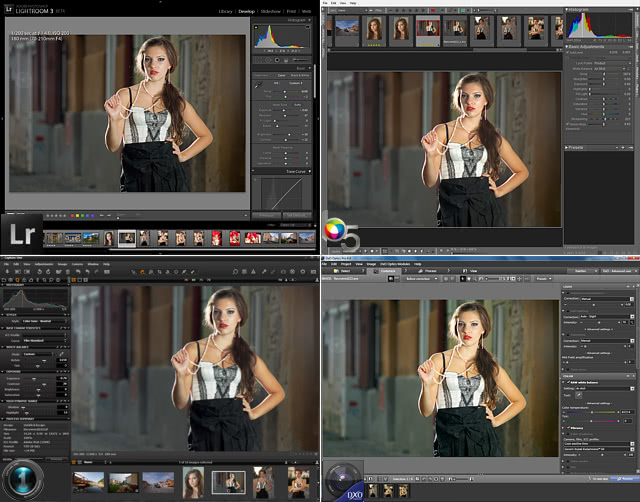
I absolutely love Capture One‘s interface. It’s polished, simple and logical. It’s very easy to find the tools and the tabs are arranged in the proper order – from capture to details.
Lightroom comes very close, but for it the keyword would be ‘customization’. You can easily customize the interface to fit your own workflow, turn panels off, even customize the “nameplate” to your company name – a nice touch for when you’re working with a client.
Bibble is more of a mixed bag. They changed the UI completely from version 4 and copied many concepts from their competitors, but it’s still a bit confusing as buttons are all over the place.
DXO suffers from the same problems as Bibble – a rather confusing interface, with options arranged not very intuitively; for example, why is White Balance (a basic setting) placed after DXO Lighting (an advanced feature)? Still, in terms of speed and stability, it’s a huge improvement over DXO5.
Import and export
Lightroom has probably the widest camera support – it can read all camera formats under then sun and it also supports DNG (obviously, they invented it). Lightroom also goes beyond the typical RAW processor, as it aims to be a full DAM (Digital Asset Manager). In two years, it still hasn’t convinced me to use it exclusively, but it’s simple enough to import photos in its database and process them. It can also handle variations, has an unlimited history, snapshots and more. New in version 3 is the export system – you can publish from it directly to a service like Flikr. For me, it would be incredible to output directly to iStock, so I can only hope a plugin will come.
Bibble also has a wide camera support, but they don’t support DNG (despite numerous customers requesting it, I might add). Import and export are very easy and I like how printing is also treated like an output option and how easy it’s to define your own presets.
Capture One has a very straightforward way for import and export, focusing on simplicity. I might add that tethered shooting is perfectly integrated in the interface, a bonus for studio photographers. Capture One is more picky about direct camera support, but it does support DNG, so you can always convert to DNG first and then import.
DXO is the most cumbersome in this regard. First you must drag-and-drop files from the file system to a project, edit them and then drag and drop files from the project to the output queue. It just feels tedious for me, without enabling any advanced behaviour. DXO is also very picky about camera support and adds lenses into equation as it provides automatic correction for known camera-lens combinations. It also doesn’t import DNG (why oh why); it can output linear DNG, a feature I never used.
Unique features
As mentioned above, Lightroom is not only a RAW converter but a complete DAM, which comes in handy when you have tens of thousands of images (I have about 16,000 DNGs since 2003). You can easily filter by multiple criteria – tip: it really helps to use keywords for all images. The unlimited history, snapshots, virtual copies help you play creatively with photos, trying different looks. On the other hand, it’s the only program in this test that does not posses any sort of lens distortion correction, which is very disappointing (I still have hopes for the final version). Since version 2, LR also has some localized corrections (color, sharpness, exposure) via a brush or a gradient.
DXO is the unchallenged master in optical corrections. If you have a supported camera and lens, the precise corrections are great, and even if the lens is not recognized, you can still apply most of the corrections – sharpness falloff, light falloff, distortion corrections, even fish-eye corrections. The most impressive feature would be the keystoning, which lets you easily correct perspective distortions – a must-have for architectural shots (not everyone has a tilt-shift lens). It also has a built-in color rendering for emulating different film looks and more.
Capture One has the best support for tethered shooting and a very useful focus checker – it will overlay the areas that are in focus, a great way to quickly asses a collection of images without zooming in, making it almost perfect for studio work.
Bibble has an incredibly powerful feature: layers. You can make a selection on the image and make any and all settings apply only to it. You can have an image with two or more different WB settings if you want. Areas can be defined using some tools or brushes and you can easily set/change the feathering. The system goes way beyond what Lightroom can offer. Bibble also has some interesting features licensed from other companies – Noise Ninja for image reduction and a lens distortion database from PT Lens.
Processing Quality
This is where the fun begins.
Color rendition – portraits
With each program, I did not rely on defaults, but tried to achieve the best look. Looking at the image below, you can still see that each one has a different philosophy:
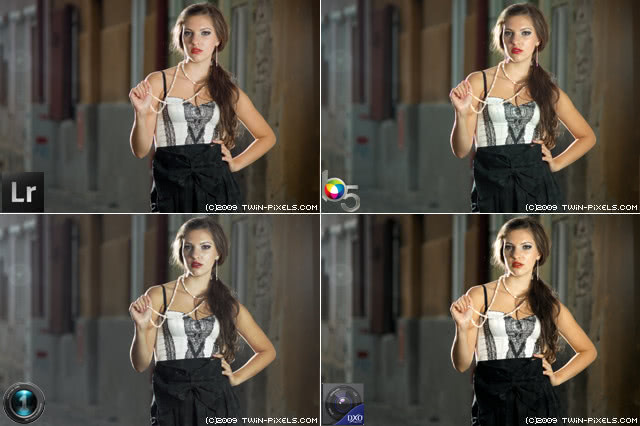
White balance was set for the black+white dress. I did not enable any “creative” color settings or film emulations.
Capture One really likes to stay neutral and true to the ‘real’ colors. Besides the WB tool, it also has a ‘skin color tool’ for achieving a pleasant skin color.
Lightroom throws more contrast; at least for my camera it has the tendency for more reddish skin, which I dislike. I know I can make my own color profiles (and I have), but how many users will?
Even with the Portrait contrast setting, Bibble generated a more contrasty image, while DXO created a very punchy result – very contasty, more yellowish skin and lipstick.
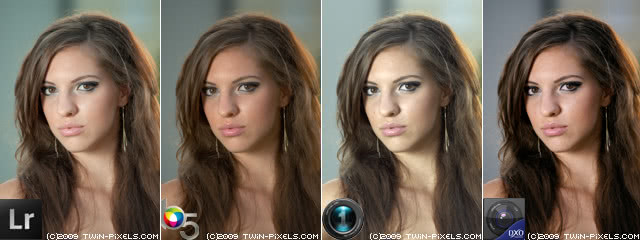
Four programs – four interpretations of the same scene with WB set for the eye white. What’s not to love?
Capture One again favors a very bland/neutral look, while DXO goes “a little” overboard with contrast. I think I like Bibble best.
Color rendition – landscapes
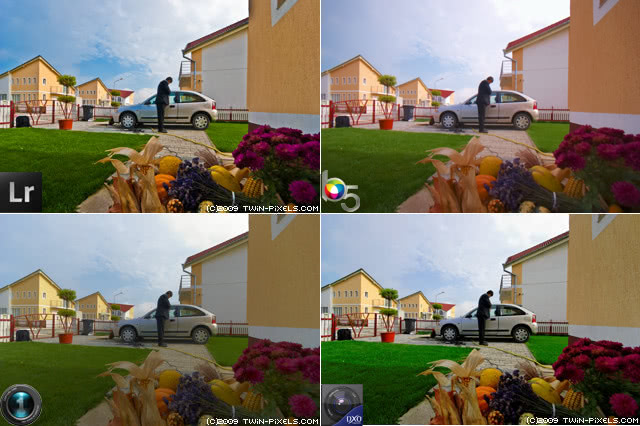
For this image I also used a little Fill Light to open the shadows in the flowers and fruits. WB was adjusted for the white wall. Both Lightroom and DXO produce beautiful colors – Lightroom with a great blue sky (not very realistic since it was overcast, but beautiful nevertheless); DXO has a bit unnatural grass, but I’ve seen the color in magazines and ads a thousand times. Lightroom also gets the purples right but gets the orange walls a bit wrong. But this is just nitpicking.
Capture One misses it – the grass seems dirty/muddy and the Fill Light doesn’t work nearly as well. Bibble fares better but the colors are off and the contrast and shadow/highlight details are not that great.
Dynamic Range
You could get a taste of how well Fill Light & Highlight recovery work from the previous test, but now lets try something extreme:
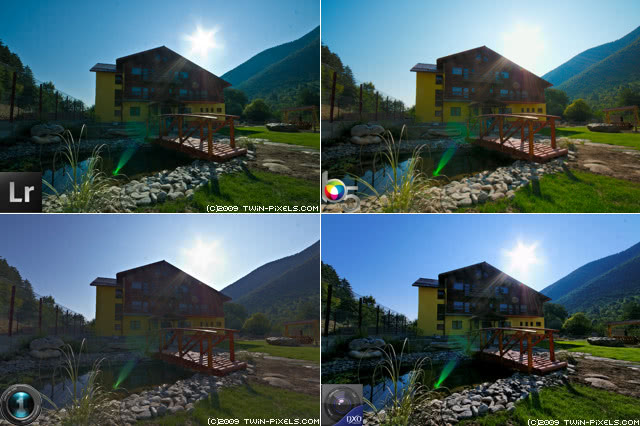
DXO is really amazing with this image. Beautiful colors and look how detailed the dark, shadowed part of the building looks. Lightroom comes in close.
Initially, Bibble generated a rather poor image in the Preview release 3, but in the final version I managed to get better results.
As for Capture One, it just can’t.
Detail extraction
Let’s see now how much detail vs. noise can our four contestants extract from an image (100% crop):
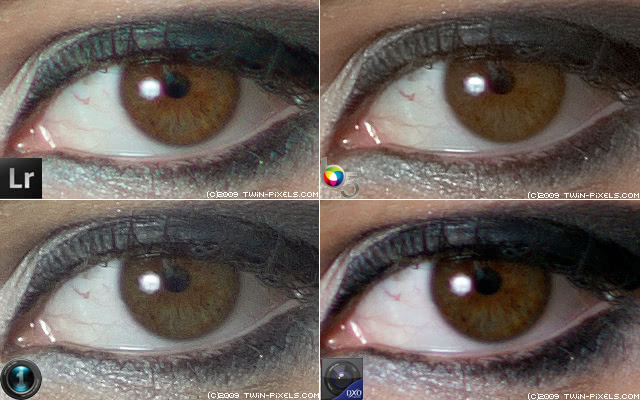
DXO produces a clean but not very detailed image, with some speckles here and there. Capture One removed too much chroma and has a quite speckled look (but note how natural the skin looks). Bibble 5 puts Noise Ninja to good use, leaving a pleasing image in terms of noise and details. Lightroom 3 renders the best image in terms of details, even though it’s slightly noisier.
Noise reduction
I don’t shoot usually at high ISO, but I have for this test- a boring detail of my keyboard.
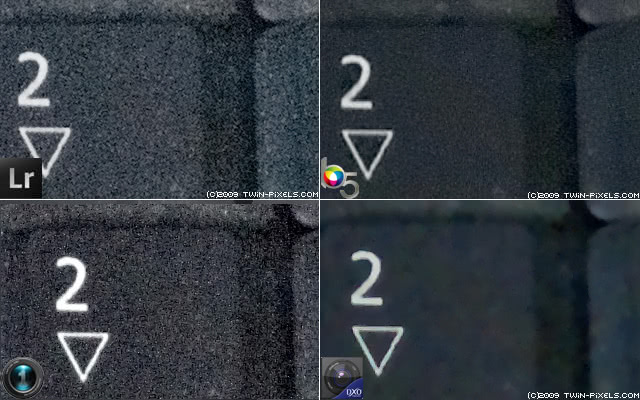
The image above was shot at ISO6400.
Thanks to Noise Ninja, Bibble gets the crown. Lightroom 3 has the luminance noise reduction disabled in the beta, so the final version may look different. Although very noisy, it’s not that bad – I prefer Lr3 over C1. DXO cleans the luminance nicely but leaves some coarse chroma noise. With Capture One I tried 2 different approaches but the results are still very poor. The one shown above has luminance noise reduction very low, chroma to max; also reduced sharpening to zero.
Optical corrections
Unfortunately I did not have any RAW picture to really have a need to correct the chromatic abberations or barrel/pincushion. As I mentioned in the beginning, almost all of my pictures are DNG.
Having said that, based on my past experience I can safely say that DXO is unmatched in optical corrections – especially with a supported lens, whereas Lightroom comes in last since it has no distortion correction.
Here’s something from a previous test in 2007:

I was able to test for purple fringing:
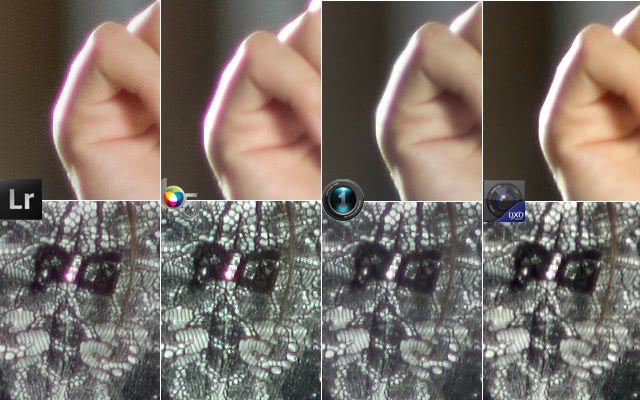
Bibble has the least effective fringing correction (I couldn’t actually see it making any difference, although the Fringing option was set to Standard). Lightroom is also largely ineffective in this area (Purple fringing was set to All Edges). Capture One corrects the purple fringing but leaves a glow. DXO corrects both the color and the luminance in the affected area, leaving a sharp image.
It’s also worth mentioning the noise – Lightroom image is noisy but detailed (look at the black lace), while Capture One’s looks clean but speckled.
Speed
Speed comparisons are not very fair, as we’re comparing apples and oranges – some programs offer more advanced corrections so it wouldn’t be fair to say that they are slow when they also offer superior quality. Also, speed is dependent on many factors and will vary greatly from image to image.
As a general statement, Bibble is the fastest, followed by Lightroom and Capture One and unsurprisingly DXO comes at the end.
Pricing
Quality is not the only factor in making a decision. Let’s see how competitive are the prices:
- Adobe Lightroom 2: $300 USD (I can only assume version 3 will be priced the same)
- Bibble 5 Pro: $200 USD
- Capture One 5 Pro: $400 USD ($130 for the standard version)
- DXO Optics Pro 6 – Elite Edition : $200 USD ($109 for Standard edition)
Some notes:
- Capture One 5 standard does not offer optical correction and tethered shooting.
- DXO differentiates Stardard and Elite based on the supported camera bodies. High-end (full frame) digital SLRs require the Elite edition.
Updates
I intend to update this article when the final versions of Lightroom 3 and Bibble 5 are released and to also add more tests – so please come back.
I will also gladly correct any factual errors that may have slipped in this review (I worked for a week on it).
Updated on January 4, 2010 with the final release of Bibble 5. I changed some three of the Bibble results and used the new sales price.
Conclusions
It should come to no surprise that there’s no “perfect” program – each one has its strengths and weaknesses and your decision on which one is better for you should be based on the type of photography you do.
Having said that, I have a hard time recommending Capture One. I really wanted to like it and I know it has its fans, but I just can’t justify its price tag vs the output quality or the workflow. The interface is nice and clean, but it has nothing worth 4 times the price of DXO or the quality and workflow offered by Lightroom. It may work well for studio photographers because of its tethered shooting features and focus checker but even then it might be worth testing it along with Lightroom.
In terms of features and quality over price, DXO 6 is an absolute steal. If your camera and lenses are supported, $110 is nothing, even if you also use a different RAW converter. If you shoot landscapes or architectural elements, HDR, ultra-wide and so on DXO is a must. DXO 5 used to be a nightmare, with frequent crashes and a very slow interface, but DXO 6 is nothing like that – it offers a solid experience and in many cases it produces beautiful results.
Bibble 5 has great potential – it’s very fast and its adjustement layers feature is truly powerful. It supports more camera models than DXO and Noise Ninja does wonders for high-ISO images (obviously, you can always purchase Noise Ninja or Neat Image separately).
Lightroom is a very good all-round program. Its image management and workflow features are very useful for professional photographers. On the other hand, it’s relatively more expensive and lacks more advanced optical corrections. Adobe has included optical corrections settings in the latest DNG standard I hopefully support will be added in Lightroom 3.
So which one is best for you?
If you’re an amateur with a compact camera that supports RAW and want to get creative, go with Bibble. It will correct noise problems and optical distortions and will let you get creative.
Landscape and architectural photographers will benefit from DXO advanced corrections.
Portrait and studio photographers who work closely with their clients and shoot thousands of photos will be best suited by Lightroom.
Capture One has its fans too. It has some very professional features but its scope is limited. I would recommend it for professional studio photographers who worry more about correct colors than high ISO performance.






88 Responses
Nice comparisons. Thanks for taking the time to do this – very useful.
I’d be interested to hear your thoughts on using Bridge and Adobe Camera Raw as an alernative. Combined, there is pretty much all of the functionality of LR and I know of several pros who stick with this method.
ACR (Adobe Camera RAW) uses the same engine as Lightroom (they’ll probably update it when LR3 is released) so in terms of speed and image quality the result should be the same.
In my opinion, ACR+Bridge can be a viable alternative to Lightroom; I do prefer LR’s interface but one should should consider whether or not a streamlined interface is worth the price tag…
exellent work, congratulations and many thanks for this comparison. regards..sami from colombia southamerica.
I am owner of Capture One 4 Standard. A year or two ago it was a good program. I have been waiting for new version but after I tested it I decided not to upgrade – too liitle features for too much money. (Note: Pleasable high ISO results can be achieved via keeping luma reduction as low as possible or turning it off completely.)
Unfortunately ACR+Bridge can’t be bought separately from Photoshop. I would buy it. (I hate all programs which uses database for storing all conversion settings.)
So I have to look elsewhere. Bibble 5 preview looks promising…
Me too 🙂
Bibble can be a good replacement if they get their act together and finish the product. First preview was released in January 2009…
The poor results in Capture One, may very well be if you were using DNG’s. DNG’s are not very well supported for input in Capture One. I think you’ll find that using the original raw’s will provide much better results.
I used original RAWs, not DNGs, as DXO and Bibble don’t support DNG. I tried to be as fair as possible with all converters.
tks for the research
sorry if i missed it – how about photoshop CS4?
what do u think is its position in our digital darkroom – i do not meant to be very creative (i know a pro defintely can use lots of its features but i am not one of them) but would just like to get the best results from my sony a900 and nikon d300
Photoshop CS4 has the Adobe Camera RAW (ACR) included, which uses the same engine as Lightroom. Therefore, in terms of quality, you’d get the exact same result using Photoshop CS4 as with Lightroom. In fact, you’d get more flexibility since you can do everything you can imagine in Photoshop. Further, if you use Bridge+Photoshop, you can more or less replicate Lightroom’s workflow. One’s preference of Lightroom over ACR or viceversa is largely subjective.
Based on my conclusions, it doesn’t matter that much what cameras you use as what kind of photography you’re doing in choosing the ‘right’ program. Both your cameras are very good and it’s normal for you to want to get the most out of them.
Very interesting to read your review.
What I do not find in your review is customer friendly use of the different software.
Capture, Lightroom are easy to work with.
DXO used to be terrible but the latest version (DXO 6) has improved a lot. It still does take a lot of time to start DXO (even on a fast computer) but the interface is very customer friendly and the results (even if you must be patient) are very good. Unfortunately it is still not possible to print with DXO.
Bibble is a disaster. The menus are ridiculous complicated and you have to be of an academic level to understand how to use it.
Printing is possible but with terrible results.
I actually covered it – maybe too briefly? – in the Interface section.
My findings are very similar to yours.
I asked a Bibble Labs employee about Bibble 5 pricing at Photokina 2008, and the price he mentioned for version 5 was higher if I remember correctly.
Also check out my own raw converter Scarab Darkroom (beta)! Although it’s still at an early stage of development, and doesn’t match up to these in terms of features yet, it’s very fast and produces images with good detail.
Hey, I know Scarab! It’s a very nice program with great potential. I wish you good luck with it!
At least with my Ricoh GX200 RAW files I get better, more detailed conversions using the free (and soon to be open-sourced) RawTherapee 2.4.1 than I do with Lightroom 3, Capture One 5 and some other well known converters (SILKYPIX, Lightzone).
http://forums.dpreview.com/forums/readflat.asp?forum=1013&message=33550119
The interface is rather poor, but if you typically only convert few pictures, then it’s more than worth the download.
Prog.
This has been SO helpful. Thankyou.
I wish you HAD included Aperture, as that would have made it perfect, (for me.)
Apart from the horrible rendering of the grass colour, which I hope could be altered,(?) I think DXO ticks the boxes for me.
However I do love a Colour wheel white balance adjust tool rather than the two sliders, temp and hue, which as far as I know only Capture One offers here. ( apart from Canon’s DPP). I also don’t know if this is included in Capture One’s basic programme, or only in the Pro version?
Tim,
grass colour can be altered. I did not use any advanced colour effects in either programs as it would have “masked” their natural preferences.
I also love the Color Wheel in Capture One, sadly it’s just in Pro.
If Apple comes up with a release soon, I will update my review to include Aperture as well.
Armand, you mention in “Conclusions” that DXO can be used with another RAW converter but as it only exports as DNG, TIFF or JPEG, and only works with “virgin” RAW files, as the first step in workflow, I don’t understand this. (Unless those programs that work with DNG, ie Lightroom and Bibble, are still classed as RAW conversion?)
Trying to incorporated the trial of DXO with Canon DPP proved impossible, the two rejecting/ignoring any changes made by the other.
Hi, Armand,
Great comparison here! I found myself coming to the same conclusions as you about color, noise, etc. A few years ago, I picked ACR/Lightroom, and I still really appreciate the color it gives me.
I was wondering if you did much comparison of the auto-tone features in these different packages. Auto-tone in Lightroom 2.5 tends to jack up the brightness, creating a photo with very little contrast, and it seems to have no common sense in setting exposure. Do LR3, DXO, Bibble, or C1 do better? I’ve tried i2e (www.colour-science.com) before, and it’s surprisingly good. It would be great to automate some of this stuff for snapshots, so I can spend my time on the photos that matter. (Are you listening, Adobe?) It’s surprising to me that a free program like Picasa has face detection and often kicks out better first-try auto-toned photos than Lightroom!
Dirk
I did not compare auto settings, because as you said they tend to perform poorly.
Over the top of my head, LR auto-tone is very weak, especially for hi-key/low-key shots. C1 I think lets you specify a metering mode just like the camera (average, center-weight, etc.) Bibble has PerfectlyClear, which works similarly to i2e, but it’s disabled in the Preview. DXO is very much auto-minded so to speak — all areas (color, noise, etc.) have automatic settings.
And yeah, face detection would be a great image management feature in Lightroom!
Hi Armand,
Would you expand on how to use DXO with a different RAW Converter?
Tim
I haven’t thought very much about it, but it would actually be a good idea. I might write an article on in before the end of the year.
It was your idea Armand!
I hope you do find time for it, it would certainly be a help, as I can’t find anything on this elsewhere. Tim
In your test of purple fringing, did you try using Lightroom’s fringe removal option, located in the Lens Corrections panel? This needs to be turned on for there to be any effect. I find that this tool does a good job with images for which the fringing isn’t too severe.
Yes, I tried both fringe removal options – “highlight edges” and “all edges” but the reduction was insufficient. We can all agree this was a case of severe fringing and that’s why I selected it. In my experience, Lightroom’s purple fringing removal works only for 2-3 pixels edges.
Armand,
I really enjoyed your review of these products. One of the items you purposefully skipped over is the relative performance of these products. Since these products are intended to improve and optimize workflow efficiency, how well they perform in a real world workflow example is an imprtant consideration. I am currently Beta Testing Lightroom 3 and Bibble 5. In addition, I have also used Lightroom 2. The following is an article I posted on the Lightroom forum:
The following are the performance tests I ran to validate the Workflow efficiency of various software programs. I ran the programs on a Dual Core Intel running WIndows XP SP3.
A. Importing a shoot of 108 images (54 Nikon RAW – NEF, 54 JPEG)
1. Lightroom 2 7:41 minutes
2. Lightroom 3 (beta) 7:34 minutes
3. Bibble 5 (beta) 5:23 minutes
4. Capture One 5 6:46 minutes
6. ACD Pro 3 5:14 minutes
I used the same metadata and keyword settings on all the imports. For the Lightroom imports, I used Standard Previews.
B. Rendering 1:1 images
1. Lightroom 2 10.29 seconds
2. Lightroom 3 (beta) 34.92 seconds
3. Bibble 5 (beta) 5.31 seconds
4. Capture One 5 6.23 seconds
6. ACD Pro 3 12.71 seconds
The above timings are per image averages for rendering 20 Raw images each.
Clearly there is a significant issue with the redering performance of LR3.
I hope that these benchmarks will be taken seriously by Adobe, as this is a significant issue which needs to be addressed before the production version is released.
Eli,
thank you for the informative benchmarks. I do remember that Lightroom 1 used to be quite slow during beta so hopefully LR3 will be faster once it’s released.
Your benchmarks also mirror my own findings when rendering 12Mp RAWs. I will add that DxO takes about 35 seconds for rendering.
Hi Armand,
Have you had a chance to look at ACD Pro 3? If so, I would love to hear your opinion.
I have used ACD Pro 3 and Photoshop CS4 as well as Lightroom. ACD Pro3 supports many more formats than almost any other program I have used, including DNG. It is fast, includes an asset managment module, allows for both non-destructive and pixel level edits, and has a very easy to use Web publishing module, all at a price which is one third of Lightroom.
Eli
I like ACD Pro image management and especially its batch processing – so much more powerful and more effective than Bridge.
I must say however that in the past I wasn’t too impressed with its editing and RAW processing… seemed clumsy.
I might run a test with ACD, Raw Therapee, Silkypix, Scarab, maybe others too – a test of inexpensive editors.
Armand,
Check out ACDSee Pro 3. They have significantly improved the Workflow and how RAW images are processed. There is a big difference between ACDSee Pro 3 and the normal ACDSee product. The ACDSee Pro 3 product is in a similar price range of Bibble. Although Bibble’s noise reduction and speed are unmatched, ACDSee Pro 3 pretty fast and is a much better asset management tool and overall workflow tool.
On another note, it appears that Adobe is well aware of the performance issues with rendering 1:1 in LR3 Beta. It will be interesting to see how much the performance is improved when they go into production, as the beta performance makes LR3 unusable for efficient workflow in my opinion.
I continue to search for one product that will satisfy most of my Asset Management, RAW workflow processing, and quality output needs. Although some of these products are getting closer, they’re not quite there yet (at any price).
Eli
Nice comparison, indeed there is no such thing as a one-for-all solution. I’m a die-hard Bibble user and have learned to live with its strengths and weaknesses, just like others learn to live with LR or other tools.
There’s one small mistake (I think): the lens correction used to be PT lens licensed in the early B4 releases, but I think this is no longer the case.
And, B5 also offers DAM 🙂
I was also favouring LR 3 before I got aware of a recent review of different raw convertes by Erwin Puts.
https://www.imx.nl/photo/leica/camera/page165/page165.html
In his comparison C1 5 is clearly superior in terms of resolving details to LR 3.
He was using very detailed high resolution charts recorded with a Leica M9, and his review motivated me to make comparisons, again with 160 ASA DNG files from a Leica taken under optimal conditions, landscape sunshine. I can support his conclusion, C1 gives more detailed and sharper images.
Thomas
Thomas,
thanks for the link.
Capture One is a very capable program designed for studio shooting under optimal conditions (top of the line lens, low ISO, carefully-controlled lighting). For a studio photographer, the tethered shooting integration and focus checker alone may be worth the price of C1.
In my test, I selected on purpose some challenging, real-world situations to stress the programs and find their weaknesses. I could have used a $2000 lens for razor-sharp, no-fringing, perfect images; instead I used an assortment of new and old lenses and two dSLR (an older entry-level and a new advanced one).
I do believe that for the majority of photographers, LR3 (maybe coupled with DXO) will bring more bang for the buck (so to say) than C1, simply because of the extra versatility.
Armand,
I totally agree, LR is the best choice under most conditions. You performed a very nice and helpful comparison. And you wrote in the introduction, that you selected on purpose challenging, real world situations. On the other hand, getting the best resolution and details out of images taken under good conditions is also a challenging situation, and I would guess that many people who are reading comparison on raw converters are also exactly interested in this.
I made my comment, also because I also learned my own lesson. It can take a lot of time to understand what you need, how to use a raw converter for optimum results, and how to relate your needs to the outcome and conclusions of specific review. If you just choose one raw converter, they are all good and you don’t make a big mistake. But if you want to get the best for your own applications it needs time and it is not enough to quickly got through the different reviews available, which sometimes come to opposite conclusions.
Thomas
I wonder why there is no mention of Nikon’s Capture NX 2? Odd software yes, but surelY worth the comparison?
Hi Richard,
this review was about the ‘heavyweights’ – software with a big marketshare, available for PC and Mac and that support a variety of camera makers and models. Nikon Capture NX2 is a very good program but I could not include it since it works only with Nikon NEFs.
I hate the French, But……
If you go to the DXO website, they have a pdf file for the integration of DXO and Lightroom – brilliant!
Do the lens correction and noise reduction in DXO and the colour and sharpness in Lightroom.
YES – I haven’t tried it but the workflow is like this:
Original RAW –> process in DxO –> export as DNG –> Lightroom –> TIFF/JPEG
That is (almost) exactly identical to my worflow:
empty memory card to PC
run the whole batch through DxO6 with standard settings
take a coffee break or have a short siesta waiting for Dxo to finish it work
import DxO’s output to Lightroom
now, the real fun begins, doing all the rest in Lightroom
Thanks for your excellent review!
Alfred
Wow — thanks for the great runup on these apps. Having been disappointed with LR2.6+ACR5.6 on the RAW images from my new Canon 7D, I’ve been searching out something different that would handle my images a little more gently. Admittedly, I was looking for something I could just “set and forget” and was looking more at the out-of-the-box experience, thinking that if the image looked good that way, it’d be easier (shorter path) to make it look great.
I forgot about Bibble (just flat forgot that it was out there), but looked at the others you did, and came down to C1 vs DxO. Your insights about C1 may have tipped me to DxO. It was somewhat of a toss-up for me, but the price of C1 and the vivid images out of DxO also have helped lean me toward DxO.
I see an awful lot of folks that really swear by the LR2.6+ACR5.6 combination, so I’m pretty convinced I’m just doing something wrong there. However, I’m a part-time photographer with a day job, so making things simple, quick, and out of the box so I can spend more time making/capturing images than just trying to get the images converted from RAW is pretty important to me.
Still some more research for me, but it’s nice to see some of the same things that I’m thinking echoed here.
Nice work!
Colin
It’s a shame to compare default settings (noise reduction section for instance) instead of tweaking the software in order to deliver the best image.
NONE of the tests were made with default settings. NONE of them.
I mentioned this specifically in the article.
For each test and each program I tweaked the settings to get the best possible results for that program. As even the “As shot” WB varied, I always started by sampling the white with the picker tool from the same area.
I am not paid by company X to say that product Y is the best nor am I a ‘fanboi’. I genuinely want to get the best possible results from my camera and it’s in my best interest to try and squeeze every bit…
For the Noise test, only Bibble was left to its defaults (Noise Ninja had its profile and produced an outstanding job anyway). There wasn’t much to tweak for LR3 as luminance noise is disabled in beta. I played quite a lot with DXO and C1’s settings and applied different strategies with C1 as suggested by other readers.
I can give you the original RAW and if you can produce better results with either programs, I’ll be happy to publish the results.
How do you do Mr. Niculescu,
Thank you for this delightful and an informative article on the RAW giants. LR and C1 are like like the Nikons and the Canons of the RAW just because of the money they have and the professional zealots heralding and serving as poster people.
When I first started only two years ago, I started with ACR 4.x and ultimately purchased into the C1 PRO license (then 3.7.8) and have been loyally using C1 PRO since the second half of 2007. With LR 3 on the horizon, I am thinking of “divorcing” C1 and picking up LR 3 when it comes out–I am hoping LR 3 would have a lens correction module where it would look up its database of lenses similar to PTLens and voila!
Then LR3 (Adobe) will really shine and I think they will win even more customers just because Adobe >> CaptureOne in regard to financial resources and programmers. Thank you for your time sir and I have an immense reverence for you and your work. Reading your article, I was compelled to try DXO Optics 6 and oh-my-goodness, its grotesque and unintuitive GUI turned me off.
My ultimate wish is for the “HDR” Fill Light/Recovery of ACR to be integrated into C1 (still my de facto RAW)-it squashed C1’s Fill Light and Recovery until kingdom come.
Happy new year 2010 sir!
Best in health,
ronald n. tan
Mr. Niculescu
Thank you for your review.
I have been a very happy user of C1 standard until C1 5 Pro has come out. As with many other posters, because of the price I am looking at alternatives. I also have in the past year started shooting with wider angle (14-24 FX f2.8 + D700 Nikon), and recently started experimenting with HDR (decided on Photomatix, for now. Best HDR is a very similar situation, each has its strength, no one does it all). As you said, there is no one simple solution, DxO is absolutely unparalleled in optical correction. I played with the optical correction in C1 Pro 5, but it is not up to the same standards. I also have come to the same conclusion that Bibble takes the cake for noise reduction.
My question is around workflow and the amount of database conversions. My concern is that moving from NEF to DNG and/or TIFF-16 to TIFF, not to mention JPEG final output, and running those through each individual programs’ interpretations of those formats introduces noise. For example, I have seen differing results in the quality of NEF processing between D200, D300 and D700 into C1 4.8, never mind conversions. Another example is that some of the filters and plug ins can only run in 8-bit mode. Is there an argument to get into DNG as quickly as possible and limit yourself to only using LR, PS and native plug-ins? Second, should one also consider the order of operations such that anything that can only be done in 8-bit mode be done last?
Finally, any comments on HDR? My limited experience has shown that it has promise, but a long way to go before all the problems are overcome. I have had success in bringing out detail in snow drifts simultaneously with jagged dark rocks that no amount of Highlight/Shadow in C1 or PS could come close to. On the other hand, aligning 7 exposures with moving subjects creates problems, noise is added, but most significantly it creates more macro effects such as subtle glows and shadows around masses.
Thanks again for your excellent review.
Hi,
First, I love that lighthouse.
The DNG question is a tough one. I started using it around 2005 because my camera at the time was producing uncompressed RAWs and saving 33%-50% space when archiving the files wasn’t too bad. I also thought DNG will get a wider support, if not from camera manufacturers directly, at least from all software makers. If you read between the lines of my article, you can guess I regret a little using just DNG, as I can’t load my old images in DXO for example. The obvious answer is that we must lobby the camera makers and software companies to add support for DNG. Nowadays support for MP3, JPG or TIFF is taken for granted, that should b the case with DNG, instead of ARW, CRW, MRF, NEF, RAW to name just a few.
Workflow, I’m trying to do as much as possible in the RAW converter and yes, leave the 8bit-only operations last.
HDR – I must admit I haven’t worked extensively with it, I have a HDR cathedral and I agree it takes a lot of tweaking to get a convincing look.
Sorry if this is redundant, my browser closed the window while I was composing an earlier reply.
It is sad that all the players in the digital imaging space were unable to come up with an open standard that supports everyone’s requirements, present and future. However, that day may eventually come as digital imaging evolves and matures. Part of the reason is that these guys are in a race with each other to produce the best imaging products, good for us. Supporting an open standard for workflow, image processing, image archiving will be critical. We do not want to be locked in to a vendor set forever. It is pretty incredible how far and how fast it has come from the days of the late 90s when 2MP noisy sensors were state of the art. With processing and processing tuned to the imaging sensor, I expect significant future advances in the next years and decades. You will also see different decisions about where to partition the processing – in-camera hardware or post processing software – which will affect the DNG choices. I believe we are still in “wild west” days for a little while, early adopters beware. Another of my concerns is around archival. I store RAW, but all the post processing and corrections we do would ideally be reproducible 10-20 years from now, so whatever software workflow we decide on has to support the legacy all the way back. Never mind what will happen to digital storage media and the readers/writers necessary. In any case, there should be a good open DNG standard as soon as possible.
I haven’t used HDR much either, but I am getting a feel for it. I am using it to go back and post process some older photos and have been able to bring out some details that I could not do any other way. HDR is ideal for those inside cathedral shots where there is a lot of small scale detail, I also think they tuned the software to do well with sunsets with a lot of dramatic clouds and reflections from the underside of the clouds. The lighthouse is the Portland Head Light in Cape Elizabeth Maine, which some estimate is the most photographed in the world. We had just had a snowstorm which was winding down in the afternoon, just in time for the sunset. Those conditions happen maybe once a year, so I don’t think you will see too many shots like those. I used HDR on those shots (bracket 5 or 7 spaced 1EV apart at 5fps) evident by the ghosts of the multiple exposures in the surf. I did not do a lot of work on processing those shots, you can see spots from the snow and frozen sea spray stuck to the lens, horizon off horizontal, etc. And I do admit they appear a little over-processed. I am working on a few chosen ones to fix all those issues, however this will take significant time.
Excellent review. I bought DxO 5 for the Mac recently, partly based on it having integration with Lightroom according to DxO. Having problems exporting the raw file from Lightroom to DxO, I just learned from DxO support that if you change the file name in any way when importing from the camera card (as in Lightroom, Photo Mechanic, whatever), you cannot then export an image from Lightroom to DxO- it will not be able to find the original file if it is changed from the name the camera gave it on capture. This is not useful, as far as I am concerned: you have to keep the meaningless camera-generated name rather than changing it to something useful/recognizable? While I like DxO, I will not change my workflow and give up renaming files. So DxO has become pretty much a no-go for me, sad to say.
Very nice quality review! I have my own opinion on Image workflow software, which I have written down here: https://www.kasbergen.com/?p=35
You basically did here what I left out: compare image quality with examples. Nice to see 🙂
Hi Armand and thanks for your informative article.
My comment has been touched on in a number of posts and is regarding workflow using different RAW converters to get the best out of each. Indeed you even partially answered the question when you proposed a DxO and LR workflow as:- “Original RAW –> process in DxO –> export as DNG –> Lightroom –> TIFF/JPEG”.
I am lucky in having DxO, LR, C1 (which rarely gets used these days), Canon DPP (never gets used) and finally Photomatix for HDR images.
I tend to use DxO when lens correction is important but process these with most of the other settings turned off. Then, because I like LR’s cataloguing capabilities, bring it back into LR as a TIFF and do my final edits in Photoshop.
It would be good to get feedback from you, or others, on the various components to use in a multi RAW processing environment. Indeed, for HDR images, I don’t think I have found a good workflow that incorporates Photomatix as compromises have to be made.
Thanks again,
Rog.
Thank you very much for this informative review.
I have written one for Aperture 3 vs ACR (PSCS4) vs Capture 1, but it’s not as detailed and scientific as yours:
http://alebaneseonline.wordpress.com/2010/02/20/comparing-the-three-raw-heavyweights/
Hello Armand,
I have had great pleasure reading your review.
I mainly shoot landscape and architecture.
Have been using Capture One Pro 5 with good results.
But I will now give DXO 6 a try.
But, I seem to be having a very weird problem.
Jpeg’s that I edit in Photoshop, and RAW files edited in C1 Pro look excellent in the programs.
But, when I open them in AcdSee pro 3, the look dull and borring.
What could be the problem?
Thank you,
Igal.
It’s the color space of the image. Basically, it’s about how a particular combination of red, green and blue values – e.g. (72, 88, 234) – will actually look or print. Most images use the so-called SRGB color space, which are the colors most monitors can display.
Professional RAW processors and dSLR cameras have the option of using the “Adobe RGB” space, which is capable of representing more colors. This is usually intended for print, resulting in deeper colors. On screen, images shot in Adobe RGB may look unsaturated and dull.
You can try enabling color management in ACD See Pro or you can convert images to SRGB in Photoshop (Edit –> Convert to Profile)
Hello Armand,
It would be interesting to see you add RawTherapee and LightZone to your otherwise detailed and excellent review!
Dear Armand,
I really appreciate the work you have done. It is very very good. I really look forward to a similar comparison of ACD-SEE Pro and Lightroom 3 from your side. I have tried C1, LR2, Acdsee pro and bibble 5. My experience is that for a workflow, the LR is simply amazing. However for viewing, exporting to flickr, and also color corrections, ACD-See pro is truly amazing and very fast. It is unfortunately slow on the exposure correction.
If in future you plan to do a comparison between the acdsee-pro and LR, please kindly elaborate on the detail extraction ability and sharpness of the two programs vis a vis each other. I understand by my experience that for sharpening the NIK application for LR is also good as per my experience.
Just for the information, I use the PEF raw files and when working on analog, I work on the Tiff files of 60mb each. I found LR2.0 takes time to build the catalog, but once its done, the processing is fast.
Yours sincerely,
Shishir
Hi,
Very good work
I would like to see the same test run with RAF files from a S5 as these files do not do well in most converters.
Thanks,
Bill
Hi – Thanks for such an in-depth review. Over the years I’ve cobbled together a workflow that works for me, despite being painfully slow. I shoot architecture primarily, and do my tethered shooting in C1, then run selects through DxO for the excellent optical correction (I found their color to have issues, less so now than with previous versions); I then save files as DNG and open in Photoshop for final color correction and compositing. I could do away DxO if there were a program that had such fine optics correction, and maybe even do away with C1 if I could shoot tethered through Bridge or something similar… but until then I guess I’m stuck. If you have any thoughts on the DxO/Lightroom connection, I’d be keen to hear it!
Cheers,
Eric
Your workflow, although convoluted, is the best we have…
Excellent comparison, thanks for your efforts!
DxO being able to export DNG, do I understand correctly I could first correct distortions and perhaps sharpness in DxO, export DNG to Lightroom and still have a raw (12-bit) format to process in Lightroom (with the distortion correction written to the DNG)?
I use the DxO > DNG > Lightroom workflow and also wondered about that. From what I can find, there are two forms of DNG: RAW and linear. My understanding is that “linear” is a converted RAW image in TIFF-based format. DXO outputs DNG linear, so the RAW conversion has been completed in DXO. As a result, Lightroom does not do any RAW conversion of the DXO output, only additional editing of the converted image.
I think you forgot to mention that Bibble5 also has DAM capabilities.
All these RAW programs have some sort of ‘Library’, but I wouldn’t call them a DAMs. A DAM is a program that is useful in itself – like ACDSee or Adobe Bridge or Picasa and so on.
I don’t know anyone who uses Bibble instead of any of the programs I mentioned. I could be wrong though so if anyone has evidence to the contrary, I’m listening.
Beware, the DAM functions in Bibble are incomplete and buggy. It tends to bite you in the ass if you try to use it for anything too strenuous. It’s a great deal safer to use it in filesystem mode.
I too, in the past, did not take Bibble (nor ACDSee Pro) seriously (I still hear of very few people using ACDSee Pro for raw conversion, although I don’t hear why). However, I think Bibble is gaining quite a following these days. Quality is excellent and develop tools more capable than any other non-proprietary raw converter / editor. I’ve never used it, but I’ve been hearing more from people who have: “if the ability to do raw editing with maximum power tools without round-tripping to a pixel editor is top priority, then Bibble can not be beat”. I’m not sure if its more capable than NX2 or Aperture3, but I’m only talking about non-proprietary competitors that support my computer (Windows).
Thanks for the review.
Somebody had played with my camera and I didn’t check before taking some hurried photos, so they were unintentionally at high ISO. I put them through my usual LR3 Beta 2 workflow.
I then found DxO and thought it would be interesting to try. I put the same RAW photos through and then saw it had a LR button in it. SO I exported them to LR.
The combined time spent in LR after DxO was dramatically less than LR alone (and I made no lens corrections in the LR3 alone batch), and the kept finals were 11 through DxO and LR and one through LR alone.
ANYBODY!!!!!
What is best for RAF (Fuji s5) files?
Thanks,
Bill
Any body know XMP compatibility between Lightroom CATALOG and Bibble Pro?
Is possible to import in Bibble 5 Pro the catalog of Lightroom 2.6?
Otherway, if I convert any image from archive (about 46,000 images) that now are in CR2 or JPG to DNG…. I think that Bibble can read fully all image files, with EXIF and IPTC data?
Is possible to apply lens corrections on DNG with lens database in Bibble?
Thanks a lot and compliments for the great comparison test 😉
Francesco Bellini (Italy)
I don’t know about IPTC metadata, but the develop settings are not transferable (between Bibble 5 and Lightroom 2.6). I can imagine somebody writing some translation code to do it, but as far as I know that hasn’t been done yet. It would be imperfect since not everything translates exactly, but I don’t think even an imperfect translator has yet been written. Maybe somebody will correct me if I’m wrong.
FYI, Adobe announced today that Lightroom 3 will get the same lens distortion correction features previously demoed in Photoshop CS5.
I wouldn’t want to be DxO Optics right now.
Photoshop CS5/Lightroom3 lens corrections don’t include what I consider the most valuable DXO correction, namely the automatic variable focus correction for variable sharpening across the image. Not an issue if you use good quality prime lenses or shoot mostly portrait and macro, but as an amateur I use mostly lesser quality zooms and shoot a lot of landscapes. Still, many will find the Lightroom3 improvements a big improvement.
Excellent point about the variable focus correction.
Still, I think DxO Optics is going to need some serious attention to keep from being swallowed up by the bigger fish. IMO Lightroom has some really strong suits, and some continued glaring weaknesses, yet has gained more market share in the last year or two than any other raw converter. I don’t know whether the answer is to go head-to-head with Adobe and try to beat them at their own game, or bow to their strengths and try and re-formulate products that fit-in…
So, here’s my take now of the four:
Lightroom 3 – excellent raw conversion quality, excellent noise reduction, near-excellent sharpening, limited lens corrections, limited local adjustments, limited color correction tools, limited plugin support.
DxO Optics 6 – near-excellent raw conversion quality, near-excellent noise reduction, near-excellent sharpening, better lens corrections, no local adjustments, limited color correction tools, no plugin support.
CaptureOne 5 (Pro) – near-excellent raw conversion quality, mediocre noise reduction, (not sure about sharpening), very limited lens corrections for non-PhaseOne backs, no local adjustments, better color correction tools, no plugin support.
Bibble 5 – near-excellent raw conversion quality, excellent noise reduction, (not sure about sharpening), limited lens corrections, much better local adjustments, better color correction tools, better plugin support.
So, do you pick one, use them all, or use some?
Personally, I primarily use Lightroom, because I got started with it and now depend on proprietary plugins. I supplement with DxO for its better lens corrections (that will decrease when Lr3 released). I don’t use CaptureOne because it doesn’t fit nicely into a Lightroom-centric workflow – if I have to edit outside Lightroom I use Photoshop… I don’t use Bibble 5 for the same reason.
If I were starting from scratch and didn’t care about plugins:
I would never be CaptureOne-centric nor DxO-centric because they don’t support local corrections. I would continue to use DxO very occasionally because it still has one very desirable feature that none of the others have (lens specific variable focus correction. actually it has volumetric anamorphosis correction too but my experience has been I can often warp to taste in photoshop and come up with more pleasing results than trying to pick spherical over cylindrical… in DxO). However, I would seriously consider Bibble 5 over Lightroom because of its superior editing features and superior plugin support (plugin support in Lr3 not known, but won’t include image data support). On the other hand, Lightroom is backed by Adobe and is here to stay – and will continue to get better with each version. I think Bibble 5 will remain a very popular alternative to Lightroom 3, but I’m not sure Bibble 7 will be a match for Lightroom 5. CaptureOne isn’t even in the competition for DSLR owners that shoot outdoors. Studio Portrait shooters using PhaseOne backs may never give it up, but people shooting high-ISO shots with DSLRs in variable lighting will never prefer it. DxO is hanging by a thread. I really really like what DxO can do, that nobody else can, but I fear those days are numbered unless they really think creatively, strategically, and intensely – DxO’s “convenience” features (e.g. DxO Lighting), won’t be enough to carry them over Lightroom & Bibble.
This just my over-simplified opinion – take with salt…
I have a Panasonic LX3 and have been experimenting with RAW convertors to see which one can pull the best image quality out of the camera’s RAW files.
My baseline workflow involves Adobe Bridge > ACR conversion (with color correction, exposure, and vibrancy tweaks) > Photoshop for automated lens correction via PTLens and automited sharpening via FocalBlade. Just like DxO, PTLens recognizes my LX3 (along with many other cameras and lenses including my seven year old Canon G3) and uses its EXIF info to correct the remaining lens distortion that ACR left in the RAW file. Its advantage is that it seems to support both more and older cameras than DxO and works neatly as a Photoshop plugin.
Recently DxO optics added the LX3 to its select list of supported cameras/lenses so of course I had to see if there were any advantages. One advantage that I noticed immediately is that DxO preserved more edge pixels from the left and right sides of my LX3 raw files. ACR seems to crop the perspective slightly when performing its own automatic lens distortion correction. This is important to me because one of the reasons I like the LX3 is its 24mm wide angle lens which when converted by ACR might end up being only be 26mm. It’s definitely noticeable.
I also liked the punchy contrast, sharpening, and lighting effects automatically built into DxO. Compared to my baseline ACR/Photoshop conversions they are definitely more detailed and appear to extract more resolution from the LX3 RAW files. I will have to do more testing to see if additional sharpening and contrast in Photoshop can match the default DxO results.
On the downside, I definitely prefer ACR’s color accuracy. For LX3 RAW files usually only have to warm up the color tetmperature 400 degrees to get beautifully realistic colors. It hasn’t been that simple for DxO. Reds trend towards orange and so I’m still searching for a fix.
The second downside is that I’m currently seeing noticeable image grain in my DxO conversions even at base ISO. I’m not sure if this is being generated by DXO’s sharpening algorithms or noise reduction routines so I’ll have to test further.
The last downside I’ve noticed is that is DxO’s workflow as a standalone convertor is much less elegant and longer than what I do in ACR. Although it can do conversions in batch I still wish it was either a Photoshop plugin or that I could send RAW images from Bridge right into DxO for conversion.
I need to spend more time with DxO to see if I can fix its default color and grain issues. If I can then I might alter my workflow around it for the sake of better image quality.
I just wanted to update my comments from yesterday based on some additional tests I’ve done.
First the good news, I think I’ve figured out DxO Optics unusual color profiles. Previously I tested my RAW files only using DXO’s default preset giving me the inaccurate color problems described above. If I switch to the “Natural colors (RAW only)” preset during customization, it gives me something similar to how ACR displays RAW’s by default. From there I raise the color temp by 400 degrees (just like in ACR) and my results are back in the ballpark compared to what I get through Bridge>ACR>Photoshop.
I also believe the problems with DxO introducing grain/noise in my RAW files that ACR did not show at all (even with ACR noise reduction set at 0) stems entirely from DxO’s “lens softness” algorithm. By attempting to sharpen the image while still in RAW DxO Optics seems to amplify both choma and luminence noise like crazy. Unchecking “lens softness” altogether and doing sharpening post RAW conversion solves this problem completely.
I also ended up unchecking the “noise” algorithm because I found that Photoshop noise reduction plugins do a better job. While DxO does a fair job of cleaning up noise, it also leaves a blotchy pattern behind just as seen in the examples of the above review. In contrast Noiseware Pro, Noise Ninja, and Neat Image all were much cleaner.
So far I still like that DxO Optics generates larger RAW files, automatically corrects for lens distortion, autmatically fixes chromatic abberation (and better than Photoshop’s manual method), and offers a punchy lighting engine. On the downside, the user interface is clearly less elegant, noise and sharpening are not really world class, and RAW processing is relatively slow. Hopefully I can adjust the DxO default preset to my liking, however, and permanently diasble noise & sharpening… that’s the next test.
I’ve been following this tread closely, as any improvement in these workflows would be of significant benefit to me. I’ve just now tried out the Photoshop CS5 trial for its distortion correction, and can’t say it’s nearly as advanced as DxO, unless I’m not using it correctly. It would seem I’ll be stuck with DxO and its color issues for the time being. (Brandon – thanks for the color/sharpening tips, will be trying those shortly). If anyone at DxO is following this, I would enthusiastically welcome the option to simply and quickly utilise only the distortion settings, with an improved RAW conversion that would retain the natural color I find when using Adobe camera RAW or C1 with default settings (i.e., retaining camera settings).
To everyone who is posting; thanks for the stories; very helpful.
At first I really did not get what you meant by Bibble not supporting DNG files, since I have been using the DNG files produced by my Samsung GX-10 since 2008. But then I read up on the subject in the Bibble 5 forums, and it is indeed true that they do not produce *general support for DNG*, but they do provide specific support for DNG files produces in-camera. Just thought I’d let others know, so that Bibble wasn’t scrapped for that reason alone. More here: http://delicious.com/lommetennis/bibble+dng+support
Carl, you are correct. I was aware of this but I did not make it clear.
Still, generic DNG support was a constant request from the community, with heated discussions on Bibble forums. Considering that many users want it and that Capture One supports it, Bibble Las should seriously consider it.
Ideally, camera makers should get together and agree upon a common standard (be it DNG or something else) rather than continue with proprietary, incompatible and often intentionally obfuscated formats (like Nikon encrypting th WB info), which do nothing for the user.
Buna d-le Niculescu
este posibil ca cu programul DXO OPTICS PRO 6 sa realizez poze HDR ??? Ptr. ca ati mentionat mai sus ca este posibil. Eu nu am gasit comanda ptr. HDR in program.
Multumesc ptr. ajutor
cu stima
Graf E.
DXO nu suportă HDR în adevăratul sens al cuvântului, prin combinarea mai multor imagini (pentru asta recomand Photomatix sau Picturenaut – vezi https://www.media-division.com/hdr-cathedral/), însă DXO Lighting şi highlight recovery sunt, după părerea mea, destul de puternice şi eficiente, astfel încât pot fi suficiente în multe situaţii.
Thanks for the excellent review. It would be even better if you’d include ACDSee Pro 3 in your evaluation. I think it is an excellent program but it would be nice to see how it fares against similar software.
Hope you’ll be able to update the review with the final release of Lightroom 3 as it brings significant new changes since the betas primarily with the introduction of Lens Correction and the enabling already of the new luminance noise reduction.
Yes, a new review will follow.
Hi,
thanks for your review. Could I kindly request you to update for LR3 final version, which now has optical correction as well as lens correction. I would be interested if DXO6 is still worth it when having the same features in LR3.
Kind regards,
Donald
Yes, a new review will follow and it will hopefully include Aperture 3 as well.
Just came across this article seven months later and this is still outstanding info. I’ve been using all these processors (except bibble) for years and am looking forward to Aperture 3 being included next time. I’m also curious about Hasselblad’s Phocus 2.5, which was just released in May. They finally opened up their RAW processing software to third party cameras (Canon, Nikon, etc) and multiple file formats (including DNG). Phocus might be in too much of an early stage for professional workflows and results, yet their photographic history can’t be denied. They seem to offer most of the basic controls that the big 5 offer, yet tethered capture is only for Hasselblad cameras at this point. It’s currently a free download … which could either mean the quality isn’t great or they’re just trying to develop a user base. Interested in your feedback …
https://www.dpreview.com/news/1005/10051201phocus25.asp
Armand,
Thank you for a fantastic review which, based on my photographic needs, pushed me towards purchasing DxO.
I tried the other 3 extensively using trial versions and was lined up to buy Bibble based both on it’s processing and it’s workflow abilities.
Having now used DxO for the last month, I find it’s output excellent but workflow very weak. It seems to be geared towards the first part of a photographers workflow, RAW conversion and that’s it! If you move, modify, rename or create a file in another package, you manually have to update DxO.
As workflow and efficiency are of major importance to anyone trying to make a living in Photography, small differences in conversion capabilities be come less important.
On this basis, LR3 and Bibble would have to score higher points in their workflow abilities.
It seems that I will now need to plug my workflow hole with LR3 or even the Bridge
Not sure if this has been pointed out, but Bibble 5 does have some decent asset management tools (if you take the time to learn to use them). I’m a wedding shooter who pushes ~8-10K photos a month and found Lightrooms importing and pre-viewing painfully slow (on a quad core machine). Bibble kicked it’s butt. Proper key wording and I can find a photo of a tree in the sun I shot two years ago in under 2 min. The interface is a bit wonkey, but if you can get past that it’s fine. I’d say the only hang up is the healing brush in Lightroom vs. the same in Bibble. LR has an edge there. Also, as LR is the “professional standard” (what ever that means) there is more support, more plug in’s and pre-sets (if you need a bunch of image color tweeking presets). I am sure that DNG will find support eventually, although Bibble’s thrust is to work with RAW files, why they would expand to a file type that is (yes supposedly open source) an output from another processor I am not sure. Like Ford making a truck that will take a Chev. motor as a drop in….
I can’t believe your comments about Apeture, without including possibly the most popular DAM for professional photographers this review is not very useful. There is no doubt that there are more Aperture users than something like Bibble.
You might want to take a look at the industry and see how many of us use Macs.
Lee, at the time I wrote that article, Aperture 3 wasn’t released yet. You’ll be happy to know that not only I reviewed Aperture 3 here, I also recommend it.
Comments are closed.